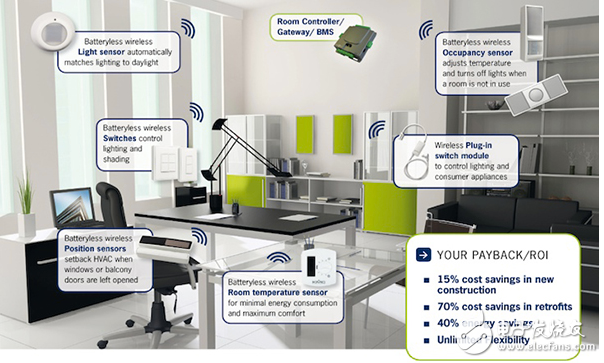
资料下载

建筑自动化中的能量收集生态系统
建筑自动化中的能量收集生态系统
在建筑物中连接传感器是楼宇自动化日益重要的特点。虽然有专有的,封闭的系统在过去,现在物联网(物联网)是提供机会打开楼宇自动化到更广泛的技术。这种物联网的建设(比奥)有自己的规格,以创建一个广泛的生态系统的设备。在Biot供电传感器和通信链路是一个关键的挑战。在整个大型建筑的运行功率引线是昂贵的资本预算,同时要定期更换传感器节点的电池是昂贵的经营预算。从环境中收获能源,以不同的方式可以大大降低安装和维护楼宇自动化系统的成本,有助于提高投资回报率。通过网关或甚至单个传感器节点添加Internet连接允许更细粒度的监控和控制,并开辟了新一代软件应用程序的机会,以进一步提高设备的使用。所有这一切有助于创造一个不断发展的技术生态系统周围的Biot和楼宇自动化一般。
使用能源收集的楼宇自动化已被证明的潜力,使一个严重的凹痕对建筑物的能源成本。这需要从使用不同来源的可再生能源,以减少整体能源消耗的论点。例如,英国的国家能源效率行动计划包括2020的目标,将初级能源消耗减少20%,达到2007。

The target is retrofitting large buildings, where 40% of the UK’s primary energy is consumed. Building automation is now a key part of the Building Renovation Strategy in the National Energy Efficiency Plan, to control systems such as heating, ventilation, lighting or shading in accordance with individual requirements.
This is not just about the individual control of temperature or humidity, but learning an occupant’s behavior automatically. Room sensors deliver data as a basis to analyze a building’s heating and cooling rate as well as its physical fabrics. Besides temperature, sensors can also detect open windows or whether the relative humidity of the air is too high. With this data, the system can automatically reduce the heating or activate the ventilation.
声明:本文内容及配图由入驻作者撰写或者入驻合作网站授权转载。文章观点仅代表作者本人,不代表电子发烧友网立场。文章及其配图仅供工程师学习之用,如有内容侵权或者其他违规问题,请联系本站处理。 举报投诉
- 相关下载
- 相关文章








